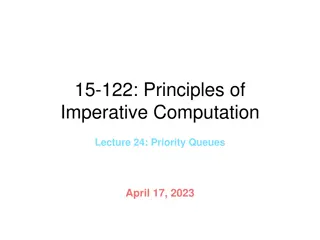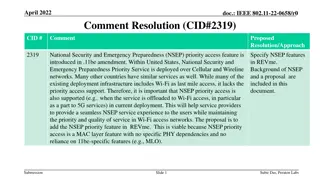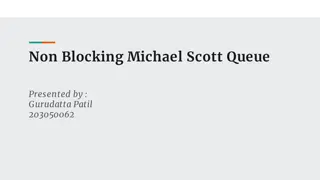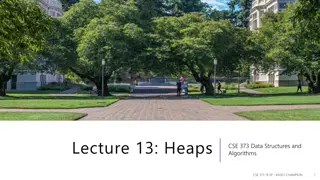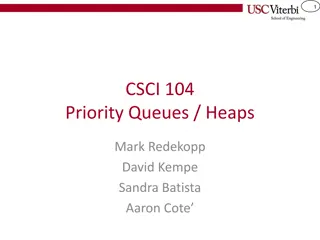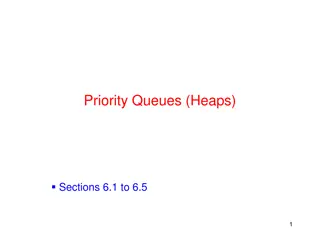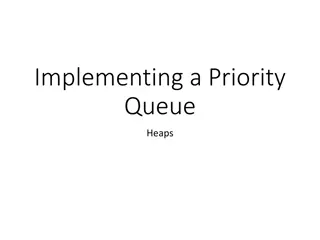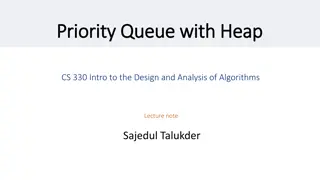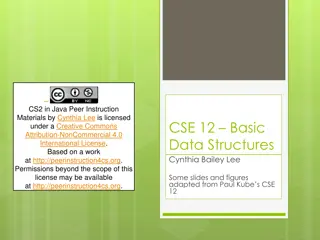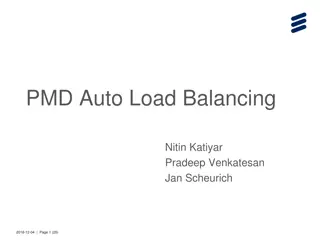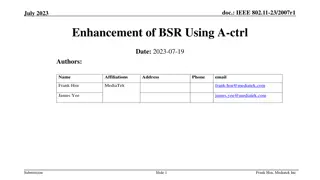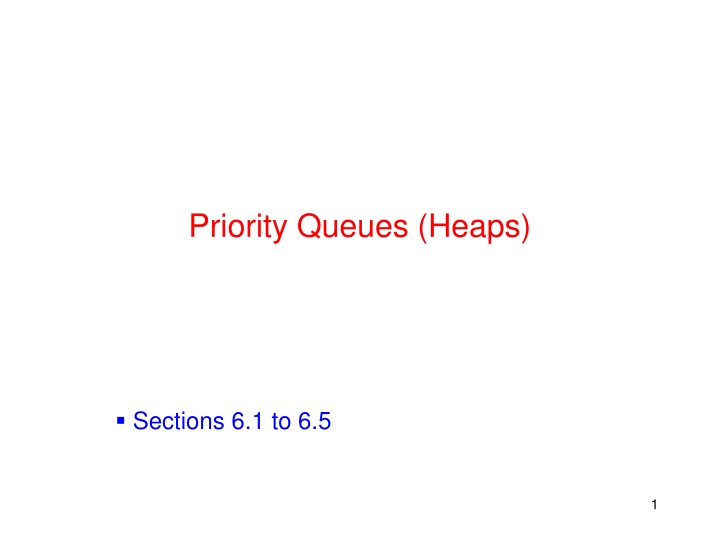
Priority Queues and Heaps in CPU Scheduling
Explore the significance of priority queues and heaps in CPU scheduling, including round-robin and shortest job first algorithms, and their impact on system performance and user experience.
Download Presentation

Please find below an Image/Link to download the presentation.
The content on the website is provided AS IS for your information and personal use only. It may not be sold, licensed, or shared on other websites without obtaining consent from the author. If you encounter any issues during the download, it is possible that the publisher has removed the file from their server.
You are allowed to download the files provided on this website for personal or commercial use, subject to the condition that they are used lawfully. All files are the property of their respective owners.
The content on the website is provided AS IS for your information and personal use only. It may not be sold, licensed, or shared on other websites without obtaining consent from the author.
E N D
Presentation Transcript
Priority Queues (Heaps) Sections 6.1 to 6.5 1
Priority Queues - motivation Consider the CPU scheduling problem: Jobs (programs that need to be executed by the CPU) come and go in a computing system A computer has many jobs that need to be executed, CPU scheduling decides which job gets to physically use the CPU. This is a fundamental problem in Computer Science For the computer system to do a good job in CPU scheduling, we need a data structure to store all jobs to be scheduled. Let us consider what data structure we should use for this purpose. 2
Priority Queues - motivation CPU scheduling round-robin scheduler Each job takes turn to use the CPU. Fairness: If a job comes earlier than another job, it needs to be executed earlier. If a job has been scheduled, it should not be scheduled a second time if there exists a job that has not been scheduled once. What data structure should we use for a round-robin scheduler? 3
Priority Queues - motivation CPU scheduling round-robin scheduler Each job takes turn to use the CPU. Fairness: If a job comes earlier than another job, it needs to be executed earlier. If a job has been scheduled, it should not be scheduled a second time if there exists a job that has not been scheduled once. What data structure should we use for a round-robin scheduler? Answer: queue First In, First Out When a new job comes, put it at the end of the queue (Enqueue()) At the time when the CPU is free (a job can be scheduled), remove the job at the head of the queue (Dequeue()) 4
Priority Queues - motivation CPU scheduling shortest job first Shortest job first always schedules the job with the shortest execution time Optimize for average wait time (user experience) Would queue still work? 5
Priority Queues - motivation CPU scheduling shortest job first Shortest job first always schedules the job with the shortest execution time Optimize for average wait time (user experience) Would queue still work? When we remove, we don t want to remove from the head of the queue, but rather, we want to remove the smallest item in the queue. The data structure that supports this is called Priority queue 6
Priority Queues Regular queue supports First In, First Out Enqueue(): add a new element Dequeue(): remove oldest element in queue Data structure supports Insert(): add a new element deleteMin(): delete minimum element in priority queue 7
Applications of Priority Queues In Operating Systems Shortest Job First process scheduling In Simulators Scheduling the next event (smallest event time) In essence Any event/job management that assign priority to events/jobs Greedy algorithms Ones that operate by repeatedly finding a minimum 8
Possible Priority Queue Implementation Implemented as adaptor class around Linked lists (or another container with linear structure) O(N) worst-case time on either insert() or deleteMin() AVL Trees O(log(N)) worst-case time on insert() and delete() Heaps This is the topic of this chapter O(logN) worst case for both insertion and delete operations Why another data structure if we can already do it with AVL trees 9
Priority Queue Implementation Heaps .vs. AVL trees for priority queue Same worst case complexity for insert and removeMin: all O(logN) The big O notion ignores the constant factor! Insert and removeMIN with Heap have much smaller constant factors than with AVL trees With AVL tree, all items are completely sorted, which is an overkill. 10
Partially Ordered Trees A partially ordered tree (POT) is a tree T such that: There is an order relation <= defined for the vertices of T For any vertex p and any child c of p, p <= c Consequences: The smallest element in a POT is the root No conclusion can be drawn about the order of children 11
Binary Heaps A binary heap is a partially ordered complete binary tree. The tree is completely filled on all levels except possibly the lowest. 4 root 3 2 1 0 In a more general d-Heap A parent node can have d children We simply refer to binary heaps as heaps 12
Vector Representation of Complete Binary Tree Storing elements in vector in level-order Parent of v[k] = v[k/2] Left child of v[k] = v[2*k] Right child of v[k] = v[2*k + 1] R root l r In this case root is at v[1]. Root can be at v[0]. ll lr rl rr 1 2 3 4 5 6 7 R l r ll lr rl rr 13
Heap example Parent of v[k] = v[k/2] Left child of v[k] = v[2*k] Right child of v[k] = v[2*k + 1] 14
Examples Which one is a heap? 15
Basic Heap Operations: insert(x) What is the shape of the heap after 14 is inserted into the following heap? 17
Basic Heap Operations: insert(x) What is the shape of the heap after 14 is inserted into the following heap? Is this still a heap? Where is the problem? How to fix it? 14 13 21 16 24 31 19 68 65 26 32 14 18
Basic Heap Operations: insert(x) Create a hole at next leaf (empty) // Repair upward Repeat Locate parent if POT not satisfied (should x inserted in the hole) Sliding parent element to hole else Stop Insert x into hole 19
Insertion Example: insert(14) (1) (2) (4) (3) 20
Implementation of insert /** * Insert item x, allowing duplicates. */ void insert( const Comparable & x ) { if( currentSize == array.size( ) - 1 ) array.resize( array.size( ) * 2 ); // Percolate up int hole = ++currentSize; Comparable copy = x; array[ 0 ] = std::move( copy ); for( ; x < array[ hole / 2 ]; hole /= 2 ) array[ hole ] = std::move( array[ hole / 2 ] ); array[ hole ] = std::move( array[ 0 ] ); } // for terminating the following loop 21
Basic Heap Operations: deleteMin() What is the shape of the heap when deleteMin is performed on the following heap? 22
Basic Heap Operations: deleteMin() What is the shape of the heap when deleteMin is performed on the following heap? 14 16 19 21 19 68 65 26 32 31 Fix the heap after move 31! How? 31 14 16 19 21 19 68 65 26 32 23
Basic Heap Operations: deleteMin() Move the last element to the root and then fix the heap! Find the smaller child. If the new element is larger than the smaller child (POT property violation), swap with the small child Repeat in the new subtree 31 X 31 14 16 19 21 19 68 65 26 32 24
Basic Heap Operations: deleteMin() Delete the root element // root becomes a hole // Must move last element (last leaf) to somewhere Let y be the last element (rightmost leaf node) Repeat find the smaller child of the hole if POT not satisfied (should y inserted in hole) Sliding smaller child into hole else Stop Insert y into hole 25
Implementation of deleteMin() / * Remove the minimum item. * Throws UnderflowException if empty. */ void deleteMin( ) { if( isEmpty( ) ) throw UnderflowException{ }; array[ 1 ] = std::move( array[ currentSize-- ] ); percolateDown( 1 ); } / * Remove the minimum item and place it in minItem. * Throws Underflow if empty. */ void deleteMin( Comparable & minItem ) { if( isEmpty( ) ) throw UnderflowException{ }; minItem = std::move( array[ 1 ] ); array[ 1 ] = std::move( array[ currentSize-- ] ); percolateDown( 1 ); } 28
Implementation of deleteMin() /** * Internal method to percolate down in the heap. * hole is the index at which the percolate begins. */ void percolateDown( int hole ) { int child; Comparable tmp = std::move( array[ hole ] ); for( ; hole * 2 <= currentSize; hole = child ) { child = hole * 2; if( child != currentSize && array[ child + 1 ] < array[ child ] ) ++child; if( array[ child ] < tmp ) array[ hole ] = std::move( array[ child ] ); else break; } array[ hole ] = std::move( tmp ); } 29
Constructor Construct heap from a collection of item How to? Na ve methods Insert() each element Worst-case time: O(N(logN)) We show an approach taking O(N) worst-case Basic idea First insert all elements into the tree without worrying about POT Then, adjust the tree to satisfy POT 30
Constructor 31
Example percolateDown(7) percolateDown(6) percolateDown(5) 32
percolateDown(4) percolateDown(3) percolateDown(2) percolateDown(1) 33
Complexity for buildheap 1 node, lg(N) ops N/4 nodes, 1 op each N/2 nodes, 0 op each ? 2 0 + ? 4 1 + + 1 lg ? Total operations: X = 34
Complexity for buildheap 1 node, lg(N) ops N/4 nodes, 1 op each N/2 nodes, 0 op each ? 4 1 +? Total operations: X = 8 2 + 1 lg ? ? 2= ? 8 1 + ? 2=? ? 16 2 + 1 (lg ? 1) + ? 8 1 + lg(?) 2 ? 16 1 + 1 1 lg(?) ? 4 1 + 2 35 ? 2=? 2, X = O(N) 2 1 lg(?)
C++ STL Priority Queues priority_queue class template Implements deleteMax instead of deleteMin in default MaxHeap instead of MinHeap Template Item type container type (default vector) comparator (default less) Associative queue operations Void push(t) void pop() T& top() void clear() bool empty() 36
#include <iostream> #include <vector> #include <queue> #include <functional> #include <string> using namespace std; // Empty the priority queue and print its contents. template <typename PriorityQueue> void dumpContents( const string & msg, PriorityQueue & pq ) { cout << msg << ":" << endl; while( !pq.empty( ) ) { cout << pq.top( ) << endl; pq.pop( ); } } // Do some inserts and removes (done in dumpContents). int main( ) { priority_queue<int> maxPQ; priority_queue<int,vector<int>,greater<int>> minPQ; minPQ.push( 4 ); minPQ.push( 3 ); minPQ.push( 5 ); maxPQ.push( 4 ); maxPQ.push( 3 ); maxPQ.push( 5 ); dumpContents( "minPQ", minPQ ); dumpContents( "maxPQ", maxPQ ); return 0; } 37
Reading Assignment Chapter 7 38

